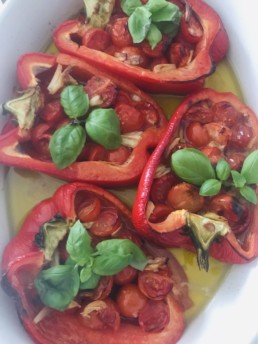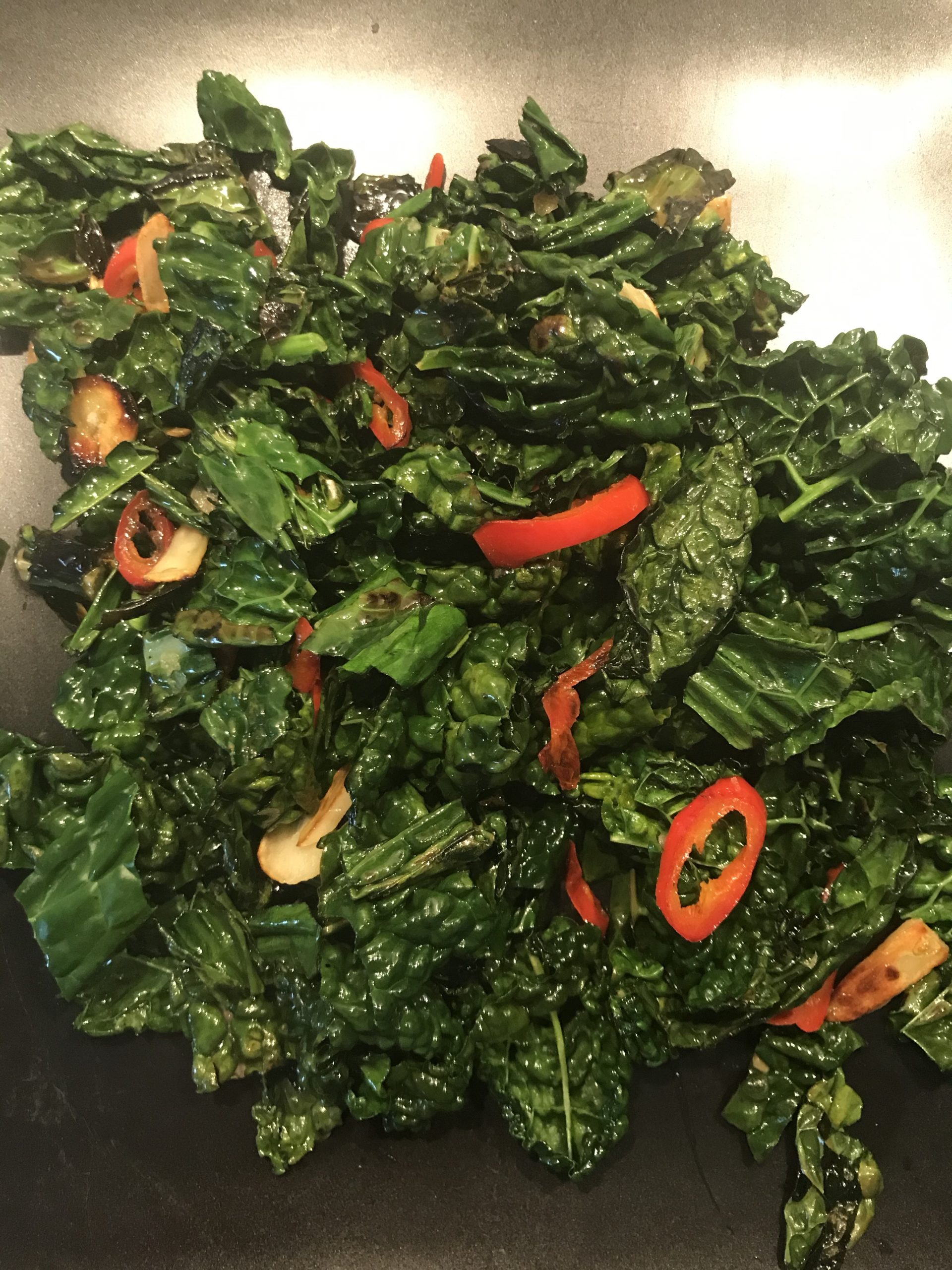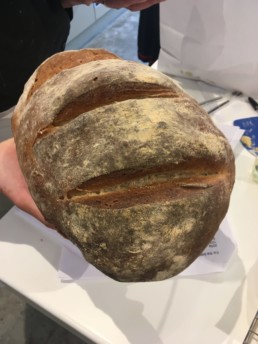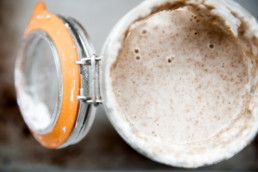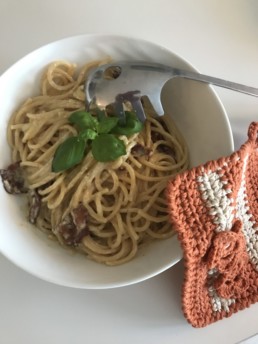What's for Supper - roasted red peppers with tomato and garlic
If you have followed my weekend blogs on baking, you may, like me, be considering to cook something light and suitable for mopping up with bread. Red peppers, tomatoes and garlic all have a fairly long shelf life in a cool fridge. I found a couple of peppers at the bottom of my veg drawer and I am keeping a constant supply of cherry tomatoes as they are so versatile and it seems readily available from even smaller grocery stores.
I also had a bag of Cavolo Nero which had been forgotten in a box in the shade on my balcony - my current extra fridge. It had just started to look a little wilted so it had to be put to good use. Cut out the thick central stalk, bunch up and slice across. Peel and thinly slice a clove of garlic or two, and a red chilli or two. Fry at high heat in sun flower oil. It will spit and splash so take care to use a long tool to give a couple of turns in the pan. Season liberally with sea salt. Both these dishes lend themselves really well for being enjoyed with bread, the juices of the peppers in particular crying out to be mopped up.
One large pepper serves 1
Halve lengthways. Remove the white pith but keep the stalk.
Halve a dozen cherry tomatoes and pile into the pepper
Peel and thinly slice a fat clove of garlic, scatter amongst the tomatoes
Season generously with salt and a little less generously with pepper
Pour in copious amounts of olive oil.
Bake until collapsed, soft, juicy and sweet. About 40 min at 180C.
Serve at room temperature.
There will still be oily juices at the bottom of the dish. Keep and use as base for salad dressings - the oil will be nicely infused by sweet pepper.
What's for Supper Weekend Bread Special 3: how to make a sour dough loaf
Our bread making classes remain the most rewarding classes to run for me and my team of Leiths and Cordon Bleu trained teaching chefs. For so many of our attending guests, they are life changing. The Beginners Bread class was the very first class that I designed back in 2009, out of our now 40 odd categories of classes. As an artisan baker, my heart and soul is in bread making in a way which it simply isn't when it comes to cakes or desserts.
If you have followed my instructions on how to make a starter and you are now the proud owner of a lively, bubbling, healthy looking starter ready to become the first of many sour dough based loaves, congratulations! Let's get baking.
Just to recap, we created a starter from 3 x 90g flour/100g water so the starter consists of 270g flour and 300g water. A total weight of 570g. I start each baking session by feeding my starter one of its 90g flour and 100g water just to give it a boost. Leave it on your kitchen work top, ie in room temperature.
After 3 hours or so, you should see a "doming" on the surface of the starter - this indicates that the starter is at its most active state and ready to start baking with.
To make a modestly sized loaf, measure out 200g of starter, of which 94.5g is flour and 105g water.
Now feed the remaining starter another portion of 90g flour and 100ml water, and leave it out for an hour or two to revive it, then introduce it to its new home: the fridge. The importance of temperature on sour dough is the first thing for any successful baker to understand. I will come back to this, but now, let's focus on making a loaf.
Add to your 200g starter 300g flour and 200g water. This brings the total amount of flour in the dough to 395g and the total of water to 305g. This means a hydration level of 77%. Hydration - ie how much water to flour - is something most bakers of sour dough will discuss and compare - to the point where it often becomes rather competitive - the wetter the dough, the more impressive! Your dough should be loose and sloppy, but not runny.
ONE MEDIUM SOUR DOUGH
200g sour dough starter
300g strong white flour or a mix of 200g white and 100g rye
200g water
7g fine sea salt
- Mix and knead until stretchy and elastic. You will struggle at first to knead such a wet dough. Use a plastic dough scraper if you have one, to lift and slap down the dough. Work it, to develop gluten, for about 8-10 minutes. Tip into a lightly oiled, large plastic bag and leave to rise in the fridge over night.
- The next morning, tip out the dough, give it a little knead and flatten out slightly, then fold in towards its centre. Repeat this, striving to create surface tension by pulling the "skin" of the dough into the fold, making a tight ball. Think of tucking hair under a swimming cap or imagine you had cling film around the dough and you are trying to putt that in to tighten. The more taut the "skin" of the shaped bread is, the more likely it is to keep its shape when baking and not shoot out odd looking bubbles on the side.
 Tip, seam side up, into a floured proving basket if you happen to have a proving basket. If you don't, just place it on a floured baking sheet.
Tip, seam side up, into a floured proving basket if you happen to have a proving basket. If you don't, just place it on a floured baking sheet.- Drape a clean tea towel loosely over the loaf and leave to prove for 2-3 hours.
- Heat oven to 210C, with an empty roasting tray at the base of the oven.
- If you have been proving in a basket, gently tip out the dough on a floured baking sheet. If your dough is already on a floured baking sheet you are ready to score it with a sharp knife - or use scissors to snip into it. This will also help the bread to keep its shape when baking.
- Tip a glass of cold water into the hot roasting tray at the bottom of your oven, to create steam and encourage crust and a quick setting of the bread's shape, and then put the bread in. This can be omitted as there is no risk your loaf won't have a good crust on it.
- Bake for 45 minutes or until hollow sounding when tapped on the bottom.
- If you wish you can of course double the quantity of dough to make a larger loaf and if so, bake it for at least an hour, perhaps a little longer.
- Leave the loaf to cool down before cutting into it to give
Understanding the importance of Temperature
When not in use, a starter needs to be kept in a sealed container in the fridge. While in a cold temperature, a wild yeast starter will be dormant - think of it as being in a state of hibernation - and will revert to looking “flat” and lifeless just like your original mixture before yeast developed. To revive it for baking, bring it to room temperature, feed it and leave it for a couple of hours to become active and healthy. If you bake every day, the starter can be kept in a cool room temperature as it will be constantly used and revived. What a wild yeast starter can’t survive is being left in an ambient temperature for a long periods of time without being fed fresh flour and water. This will result in the "bad" bacteria winning the war over the good ones, and the starter will start to smell very strongly acidic and vinegary and will eventually succumb - the bad bacteria will have won the battle over the good ones. With patient, constant feeding at regular 2-4 hour intervals, you should be able to nurse your poorly starter back to health. To maintain a healthy starter, feed it weekly by bringing it to room temperature, decanting off a little, then feeding it fresh water and flour and returning it to the fridge once revived.
Sour dough fans have been known to bring their starter out with them in the garden – sitting quietly under a rose bush or on a garden table, meeting new, incoming yeast spores. Looking after sour dough is a nurturing process. Look after your sour dough, feed it, refresh it and use it regularly, and you will be rewarded by exceptional bread.
What's for Supper Weekend Bread Special 2: breakfast milk rolls
Our bread making classes remain the most rewarding classes to run for me and my team of Leiths and Cordon Bleu trained teaching chefs. For so many of our attending guests, they are life changing. The Beginners Bread class was the very first class that I designed back in 2009, out of our now 40 odd categories of classes. As an artisan baker, my heart and soul is in bread making in a way which it simply isn't when it comes to cakes or desserts.
Having freshly baked bread for breakfast is such a joy. These little milk rolls are quick to mix and bake, and require the usual hour or so to rise. When milk and perhaps a little butter is added to a dough, rather than just water and perhaps a little oil, the resulting bread will be light, soft and fluffy. No crust, just pillowy loveliness.
My freezer is pretty full at the moment, so I bake in small batches. That way all rolls can be enjoyed while still slightly warm, with lashings of butter and I also very much enjoy starting my day with baking. You can easily double the quantities. Halving what is already a small batch would not work so well.
6 rolls
20g fresh yeast or 5g quick action dry yeast (just under one full sachet)
30g melted butter
175ml milk
1 heaped tablespoon caster sugar
1 teaspoon sea salt
300g flour - strong, plain or a mix of the two. Using 1/3 rye, but no more, works really well.
If you are using quick action yeast it can go straight into the flour dry, as long as your liquid is a little warmer than tepid.
Start by melting the butter - in a saucepan, the old fashioned way, or in a microwave.
Add the milk, stir/heat until just a tad warmer than you are. About 38C.
Place the yeast, fresh or dried, in a mixing bowl.
Pour over the warmish buttery milk. Stir to dissolve the yeast as you do so.
Add sugar and salt, followed by the flour.
Stir in, and when all the flour is added, sprinkle a little more on the dough in the bowl, put your wooden spoon away, stick your hand in, and knead. Turn out on a very sparesely floured work surface and knead and fold the dough. Knead using the base of your palm, pushing dough away from you to stretch it, then fold it back on itself. Repeat.
The stretching creates gluten, the folding helps to trap air for the yeast to work in.
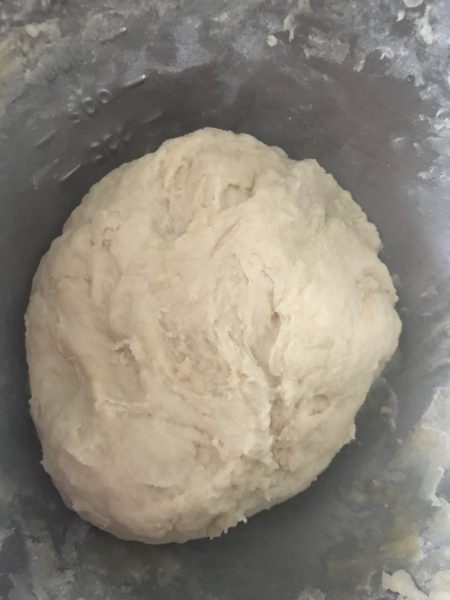
Knead like this for 4-5 minutes. You will see how the dough changes from "ropey" and ragged, as above, to looking glossy and smooth. To find out if you have kneaded enough to create the gluten needed for good bread, do a "gluten window" test as shown in the little clip below. You should be able to stretch a thin membrane without the dough breaking. If it breaks up, knead for another 30-60 seconds - it can be that quick. Gluten is made by mixing flour and a liquid and then stretching and manipulating it. Long molecular gluten strands to give the bread its lovely texture are created and that's what you want.
Rinse out the bowl, or grab a new clean one, sprinkle a little flour in the base and drop the dough in. Cover with a clean tea towel or some cling film. Leave for about an hour to rise, in a sunny spot on your work top. The dough should now look beautifully domed as below.
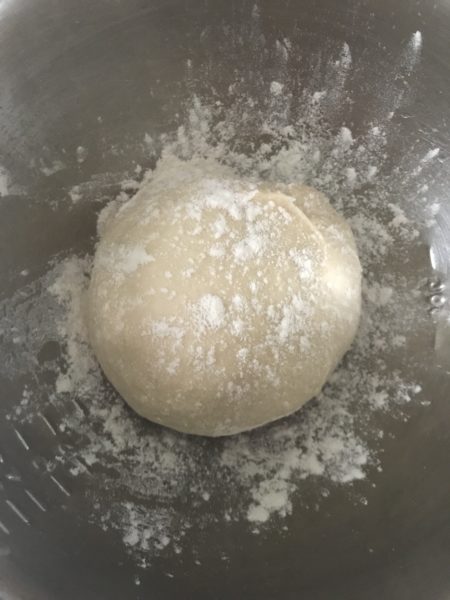
Tip out the dough. It will feel very light and tender. Give it a few gentle folds, then shape again and cut into 6 or 7 equal pieces. Shape each into roll.
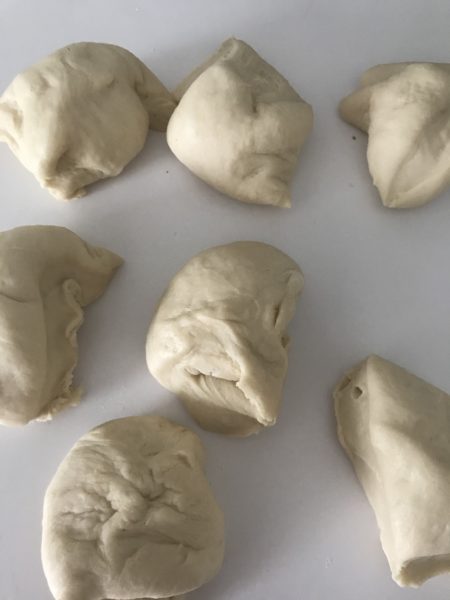

Switch your oven to 210C. Dust your rolls with a little flour, or brush with a little milk.
Leave them somewhere warmish, say in a sunny spot in your kitchen, no warmer, to prove while your oven comes up to temperature.
Bake in the middle of the oven for about 13-14 minutes.
Baked bread will sound hollow when you give it a little tap on the bottom, as it were.
Leave to cool down a little before devouring but don't leave for long as fresh bread starts to go stale the minute it comes out of the oven. I like topping my rolls with some nice, nutty hard cheese like Gruyère and a dollop of black currant jam, the Scandi way. Sounds odd? Try it.
What's for Supper Weekend Bread Special 1: making a sour dough starter
Our bread making classes remain the most rewarding classes to run for me and my team of Leiths and Cordon Bleu trained teaching chefs. For so many of our attending guests, they are life changing. The Beginners Bread class was the very first class that I designed back in 2009, out of our now 40 odd categories of classes. As an artisan baker, my heart and soul is in bread making in a way which it simply isn't when it comes to cakes or desserts.
Quite a few of you have got in touch with questions relating to the lack of flour and keeping sour dough starters alive and well. Sour dough is, as those who bake it know, in a category of its own. Working with natural yeasts and ferments is so very different from baking bread with commercial yeast. But now is the time to try our hands at something different, and I thought I would create a post about how to create a sour dough starter.
A starter is made simply from strong organic flour and water, in more or less equal quantity. I usually work with a starter which consists of 90g flour to 100g water. We keep litres of it in our kitchen at the school but at home you probably don't wan't to store more than 500g. Organic flour is important to ensure that there are no chemicals inhibiting the natural yeast bacteria in the flour.
These were my pots of starter during the 3-day creating process earlier this week.
The images don't convey the change in texture that you should expect, so here is a little film to show consistency
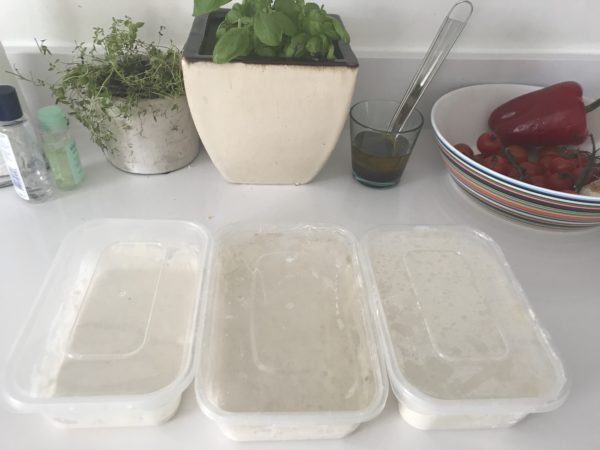
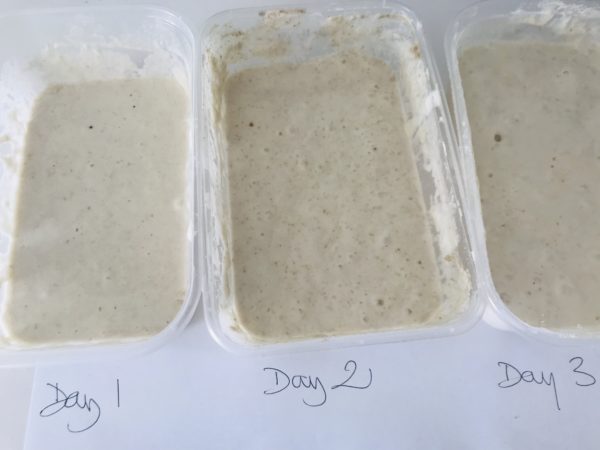
Day 1: 90g strong organic flour/100g water - creates a dense, flat gloop
Day 2: 90g strong organic flour/100g water - starting to develop air bubbles
Day 3: 90g strong organic flour/100g water - plenty of action, lots of air bubbles
Leave this on the kitchen work top - or outside, to capture local wild yeast spores in the air over the course of the 72 hours. To encourage yeast development when you first make a starter, you could add a few dried raisins or a little honey. Once the starter is healthy, it should be kept in the fridge. If left on the counter top in a warm kitchen, the fermentation will carry on and tip the balance of bacteria until it becomes a black, stinking mass. That requires emergency measures.
When I am getting ready to create a dough, I feed my starter again and leave it on my work top, in the warmth of my kitchen, to ensure it is at its most potent. Usually that will take about 90 minutes to 2 hours. This is what it should look like STARTER READY TO WORK WITH
If you have a starter already but have run out of strong and/or organic bread flour, you can feed your starter any flour, just to keep it alive and healthy. A plain flour won't have the gluten content required for making a good, structural bread, but it will sustain your starter until you can get hold of strong flour. Non-organic flour will have very little natural yeast spores left in it but you can help it along by placing the starter outdoors. You can use rye, 00 flour, plain, wholemeal, seeded, brown, spelt - anything but self rising. I know it's obvious but I will point it out anyway; self rising contains dry commercial yeast and it would kill off your wild ferment. A sour dough starter fed mainly on plain, or other less glutenous flours over a period of time can still be used to bake with. Try making milk rolls - recipe coming tomorrow - or enriched dough for cinnamon buns, hot cross buns etc where you are not aiming for a rustic loaf, but softer types of rolls and baked goods.
What's for Supper - Laxpudding or Swedish potato and smoked salmon gratin
Laxpudding is one of the most quintessentially Swedish dishes alongside Jansson's Temptation and Meat balls with lingonberry jam. It is a cheap everyday dish, despite the use of smoked salmon, of which one does not require very much. The main ingredient is the backbone of Swedish cuisine - potato, combining it here with a savoury custard of milk and egg, and of course dill, the herb which infuses so much of Swedish food and drink. Originally, Laxpudding, which hales from the far north where my mother grew up, was traditionally made using home cured Gravad Lax. Salmon was so commonplace on the Swedish table in the early 1900s that people were bored with it and begged not to be served it every day. The Bothnian Bay and the many rivers in the north were teeming with wild salmon so it was a cheap and common place protein.
Laxpudding has become one of the most popular dishes on our lunch menu in the café and I also think that it makes a perfect, light Friday Night supper served with a salad on the side.
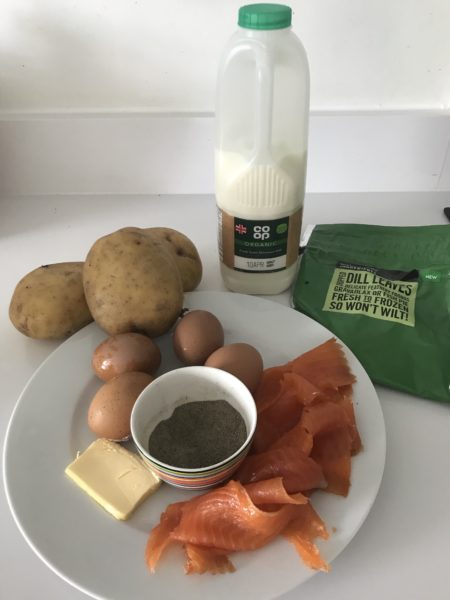

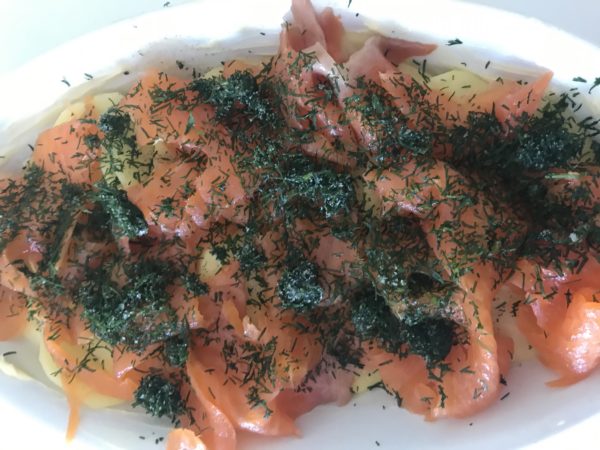
For 2
2 small or 1 large King Edward or similar potatoes, peeled and sliced
150g smoked salmon, torn into smaller pieces
1 tablespoon of finely chopped dill (I have fallen in love with the frozen herb bags from Waitrose)
3 eggs
300ml milk or combo of milk/cream if you have cream sitting around
Sea salt and black pepper
Set the oven to 180C.
Peel and slice the potatoes.
Using a fork, mix the eggs with the milk/cream
Butter an oven proof dish.
Arrange a layer of potato in the base followed by the salmon and dill.
Season with ground black pepper and some sea salt - not too much as the salmon is salty.
Top with a second layer of potato.
Pour over the eggy mix.
I like to dot a few small pieces of butter on top before placing in the oven.
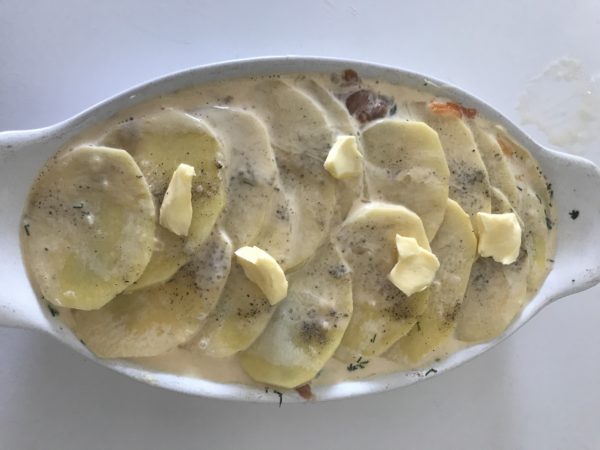
Bake for approx 45 minutes.
In Sweden, Laxpudding is served with melted butter and rye crisp bread on the side.
When enjoyed as a mid-week lunch or supper the drink of choice would be water or low alcohol beer. My wine recommendation for this salty, umami-redolent and creamy dish would be an equally rich white, say a Chardonnay or a Côte du Rhône Blanc.
Laxpudding is a must on any table for Easter, Midsummer or Christmas, the three big food events in Sweden, and for which more or less the same dishes are served. We stick to what we like! The classic drinks accompaniment for the festivities are lager and snaps - the much loved Swedish aquavit. Often flavoured with dill and cumin, and served ice cold in small shot glasses, it is the perfect accompaniment for Sweden's many salty, cured and pickled dishes.
We tend to get emotional when we eat and drink these iconic dishes, which means we want to sing. The songs accompanying snaps are plentiful and usually rather ribald. The themes are, to put it mildly, somewhat repetitive; the appreciation of snaps, the life enhancing qualities of snaps and a call to focus on where the next snaps is going to come from. The play on words, full of double entendre, is often rather clever - even if it relates mainly to the celebration of inebriaty, its effect on various bodily functions - not all negative - in a fashion that most 5 year olds would love. That's us Swedes - a basic lot. Skål!
Join me again for a weekend of home bread making
Judging by the disappearance of flour and yeast from the shelves even before the lockdown was announced, I assume that most of you have both these things in your pantry and that you might like a bit of advice on how to make fantastic bread without much effort! I am going to post the first of several blogs on Sour Dough today, so those who wish can create their first starter today. For tomorrow morning, a super simple recipe for little breakfast milk rolls.
What's for Supper - Nettle soup with poached egg
Next time you go for your daily walk, bring gloves and a bag and go in search of young nettles. Given how rampant they are, it shouldn't be very difficult. These vitamin bombs, packed with vitamin A and C, as well as iron and other minerals, have been used for medicinal purposes through the ages. Nettle soup was a seasonal thing on our table when I grew up, but how many people make it these days? I was given a bag of tender nettles by my next door neighbour as she returned from her last day of freedom, having received the letter to tell her she is one of 1.5 million who have to completely isolate. Such a kind gift and also a reminder that now we have more time on our hands, we should be more mindful of the nature on our door step. Enjoying birdsong, the magenta pink inside daisies spread across meadows, the warmth of the sun on our face. Nettles, like spinach, have an affinity with eggs and share the earthy flavours of spinach. The nettle soups of my childhood were served with half a soft boiled egg in the bowl. I prefer a less frugal poached egg. If you are a vegan, this soup has plenty of flavour as it is, sans egg.
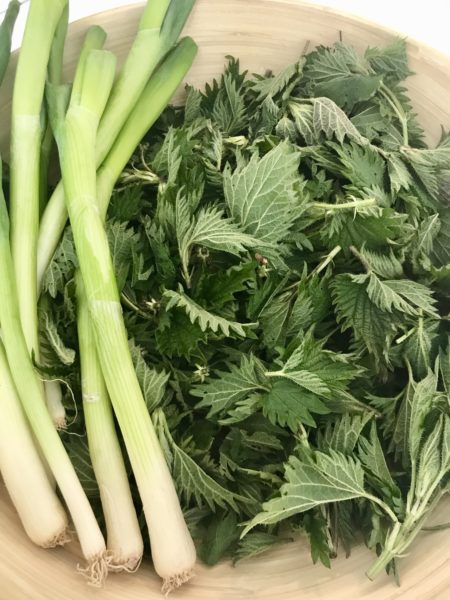
Recipe for 2
1 litre tender nettles, washed and patted completely dry
4-5 spring onions
A knob of butter and/or a little sunflower oil
1 tablespoon plain flour (gluten free if you like)
500ml vegetable stock
100 ml cream or a large dollop of Crème Fraiche (dairy free if you like)
2 eggs
1/2 teaspoon white wine vinegar
Sea salt and ground black pepper
Tender nettles don't have much stinging power, and as soon as they are cooked, they loose their sting entirely. If you are worried about getting the odd sting while preparing the nettles, use scissors rather than a knife to roughly cut the nettles. Slice the spring onions.
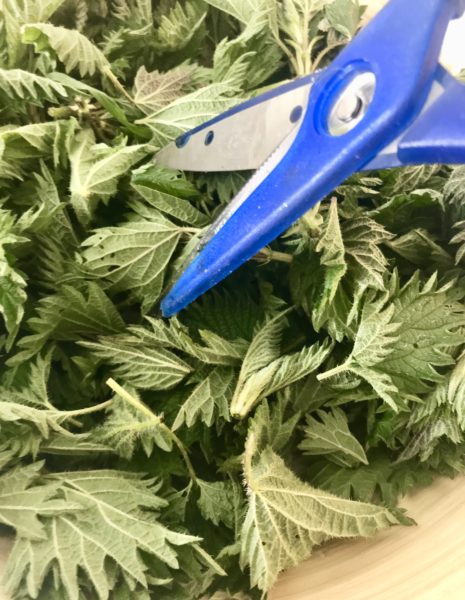

Heat butter and oil in a saucepan, add the nettles and the spring onion, season with a good pinch of salt and cook over a medium heat for 2-3 minutes. You will find that you need to add a bit of water to prevent the nettles from sticking to the pan and a bit more again to blend the nettles and onion. Use a stick blender or transfer the nettles into a blender, food processor or NutriBullet and blitz.
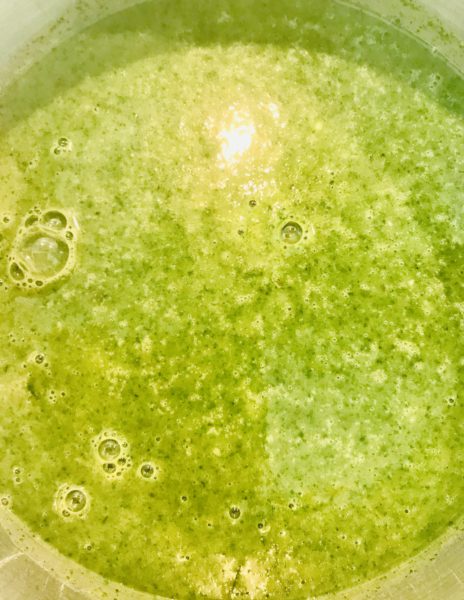
Return to the saucepan, sprinkle over the flour and gradully, while stirring to avoid lumps, add the stock. Allow to simmer for a few minutes. You could enjoy the soup like this, but it will taste even more delicious if you add a little cream or Crème Fraiche.
Check the seasoning - I used my usual hob-side trio of sea salt, caster sugar and black pepper. My grandmother Greta taught me how transformative a pinch of sugar can be. I also find Marsala to have the same transformative powers. The Sicilian sweet, raisiny wine improves the flavour of just about everything, in particular soups but also, I would say, the mood of the chef.

Perfect poached eggs
The knack of poaching a perfect egg comes naturally to some, while others never get the hang of it. However, success is not down to luck or chance. Follow these rules and you will produce decent, possibly even perfect, poached eggs. Firstly, the fresher the egg, the more elastic the egg white and therefore the more easily it will set in a tidy fashion. Secondly, poaching means cooking in barely moving water. It is not the same as boiling, which will result in rubbery eggs. Thirdly, drop the eggs in close to the surface of the simmering water. And lastly, add something acidic, for instance white wine vinegar or lemon juice, to the water as it will help to set the egg white.
The pan should leave plenty of space for the egg/s. I much prefer using a wide, open pan like a sauté pan to using a deep saucepan. Fill with water, add half a cap full (as in the cap on the vinegar bottle or roughly 1 small teaspoon) of white wine vinegar or a little lemon juice and bring to a rolling boil. As you do so, crack the eggs into glasses or ramekins. When the water reaches rolling boil, place the edge of the glass or ramekin as close to the surface of the water as you can and gently but swiftly allow the egg to slide into the water. As soon as this is done, turn the heat down to low. Watch the water. Bubbles should appear sporadically. Leave the egg for 3 minutes. Do not worry if the white has spread out - you will be pleasantly surprised at how neat your egg will look once you have fished it out and, if needed, trimmed the edges a little. Be gentle when you lift out the egg and place it on double folded kitchen paper.
The enrobed yolk should, when gently prodded, feel very soft to the touch while the white should be set. There is simply no point in choosing poaching as your cooking method if you don't like soft yolks. If a firmer yolk is what you desire, you might as well boil your egg.
Have fun in the kitchen - cook with your children and let them loose on gadgets. Just make sure that lids are firmly on and that hands are kept away from any moving parts.
Join me again tomorrow
As usual, no sooner have I finished one meal than I ask myself what I might like for supper tomorrow. I think something from my native Sweden, involving potatoes, eggs, milk, a smidgeon of smoked salmon (2 weeks ago I cut a large pack of smoked salmon straight through the plastic into smaller pieces which made it easer to find space for it in the jam packed freezer). And of course, what kind of Swede would I be if I didn't also have lots of dill in my freezer. And for the weekend, I will be showing you how to make bread!
What's for Supper - Classic Carbonara
The weather is still chilly in Cambridge and despite several layers, I returned from today's run (alright, jog) feeling cold and craving comfort food. A combo of salty bacon, egg yolk, cream and cheese; pasta Carbonara is a bear hug of a dish. My choice of pasta is Bucatini - long hollow pasta tubes. Not sure how to explain exactly why I love Bucatini so, other than that Bucatini are satisfyingly substantial, but also very light because they are hollow. They are just delicious and fun to bite into. But obviously, any pasta will do.
120g dry pasta
4 tablespoons of salt for 4 litres of water
8-10 rashers of smoked bacon
1 lug of sunflower oil
2 egg yolks
100-150 ml cream - any kind you like
2-3 handfuls of grated cheese - Parmesan or Pecorino are best but any hard mature cheese will taste great
Ground black pepper


How to cook perfect pasta
You need a really large saucepan, and 1 small tablespoon of salt per litre. That's right - 1 tablespoon of salt per litre. Nothing else - no oil. It is the volume of water which ensures that pasta strands don't stick. Cook your chosen pasta for a couple of minutes less than suggested on the pack. The salt and shorter cooking time will ensure al dente pasta - that is to say pasta that is cooked, yet retains a little bite at the core, easing the effect of this rich dish on your gut and on your blood sugar levels. For Bucatini this means about 8-9 minutes. When cooked, lift the pasta using a pasta fork - don't drain into a colander. This removes the need for dangerous lifting and moving of large pans full of hot water and also eliminates the risk of burns to hands and lower arms. The purpose for the cook, however, is to transfer pasta straight out of the water and into the waiting sauce. If you have never tried this you'll be amazed at the difference it makes to any pasta dish, compared to topping quickly drying pasta with a sauce.

Bring the salted water to a rolling boil. This is what a rolling boil looks like. Don't put a lid on and keep an eye on the pan. Give the pasta a stir when it first goes in.
While the pasta cooks, put a little oil in a cold frying pan. I use sunflower oil for all frying. I use extra virgin olive oil for drizzling on towards the end of any cooking process and for cold preparations like salad dressings. The reason is that sunflower oil has a high burn point and the added benefit of being neutral in flavour. It is also inexpensive. Olive oil, like all refined oils, has a low burn point and in addition is expensive and has a delicate flavour best suited for adding cold. Add the bacon - I use my kitchen scissors for cutting bacon. Whack up the heat under the pan to max. Turn it down a notch once the fat starts to spit but keep it reasonably high. Cook until crisp.
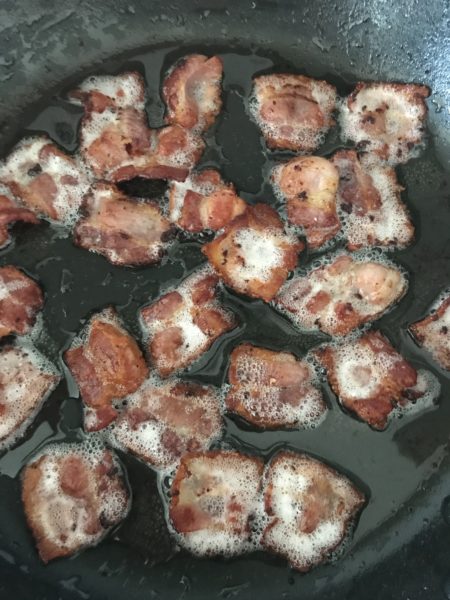
Turn the heat off when done but keep the pan of bacon as it is. You are going to use all that gorgeous released bacon fat.
Next, use a fork to mix egg yolk, cream and a large pinch of black pepper - the "charcoal" alluded to in the name of this dish from the Lazio region. Grate the cheese. Mixing the eggs with the cream before adding them to the hot pasta means the eggs won't scramble.
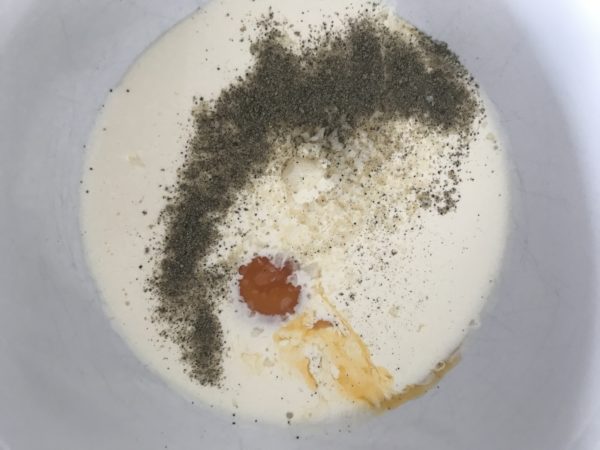
As the pasta enters its last minute of boiling, turn the heat back up under the bacon. Enough for a gentle sizzle.
Using a pasta fork, lift the pasta out of the water, with some of the water that clings to it, and straight into the pan of hot bacon. The water will help to emulsify the sauce. Turn the pasta through the hot bacon, then add the eggy cream and the cheese. At this point I like to add a lug of olive oil as well - in the grand scheme of fats in this dish, why not? Quickly fold it all together. The heat should be high enough to thicken the sauce and coat the pasta, but not so hot that the ingredients cook or stick to the bottom of the pan. Serve immediately, in warm bowls.
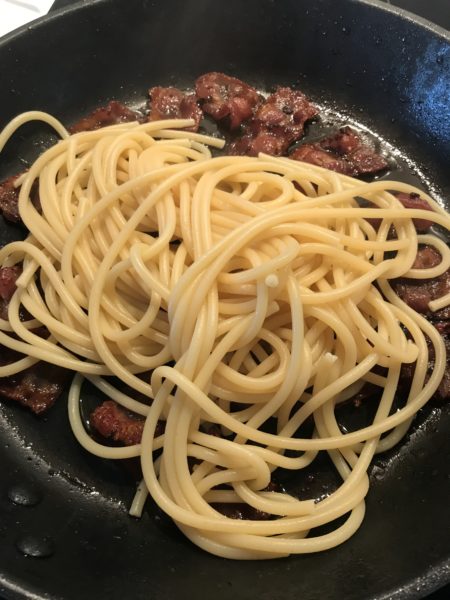
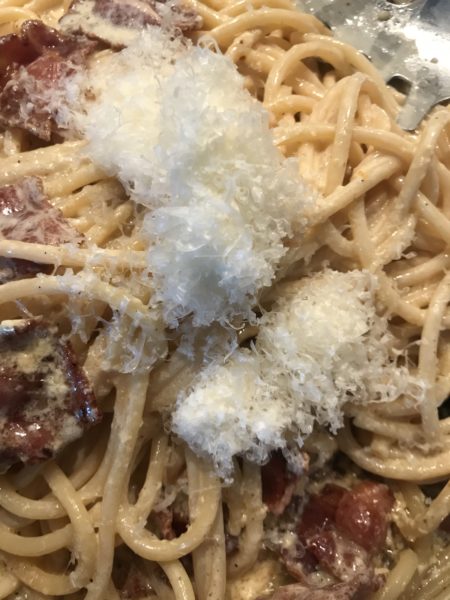
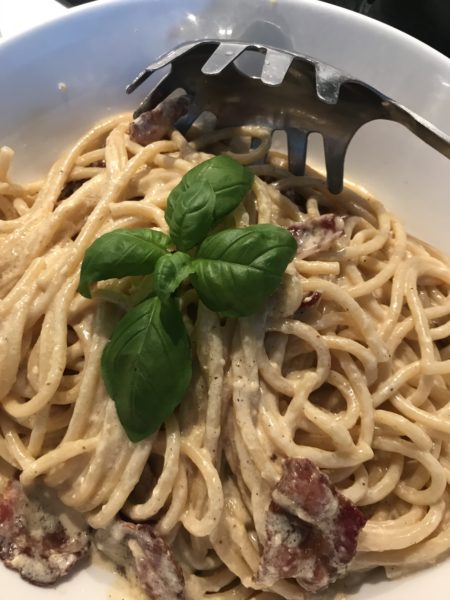
Leftovers can be turned into tomorrow's lunch as they are. However, if you are at home, with time on your hands, why not transfer leftover pasta into an oven proof dish, mix a few eggs with milk and/or cream and pour over the pasta then bake in the oven until set and golden. Serve it with a salad of some sort - any raw vegetables are good and deliver healthy fibre.
Bucatini make handy straws...
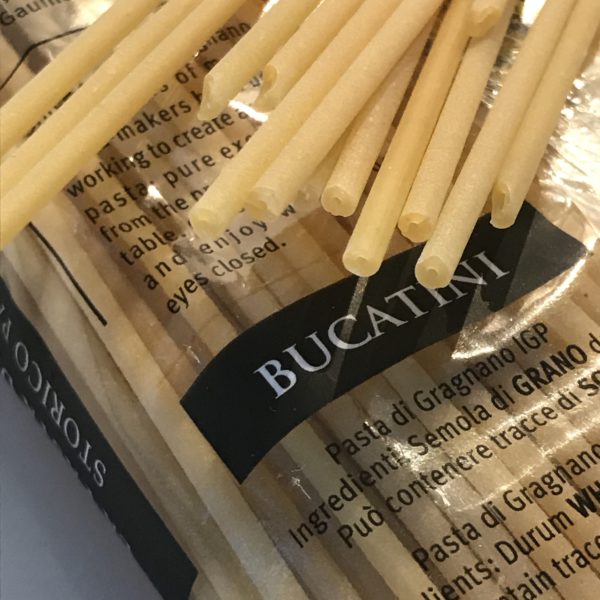

Join me again tomorrow
As usual, no sooner have I finished one meal than I begin to think of the next. This afternoon I was given a bag full of freshly foraged, tender nettles by a kind neighbour so the choice is easy. Tomorrow's supper will be a vitamin packed nettle soup with poached egg.
Recipe of the month - July 2019
Rhubarb Tart
Ingredients:
Pastry
170g plain or “00” flour
A pinch of salt
2 tablespoons caster sugar
100g cold butter
1 egg yolk
1-2 tablespoons cold water
Custard aka Crème Pat
290ml full fat milk
1 teaspoon vanilla paste
2-3 free-range, organic egg yolks
2-3 tablespoons caster sugar
1 tablespoon plain flour
1 tablespoon corn flour
Rhubarb
A little sugar
Edible flowers to decorate
- To make the pastry, measure the flour, salt and sugar into the bowl of a food processor fitted with the steel blade. Add the butter in little cubes and pulse until it resembles breadcrumbs.
- Mix the egg yolk with the water and add enough of this mixture to the flour breadcrumbs to just combine.
- Scoop out the pastry, flatten into a disc, wrap in clingfilm and place in the fridge for 20 minutes.
- Pre-heat the oven to 190C.
- Roll out the pastry on a lightly floured surface. Use gentle movements and don’t over-work.
- Use the rolling pin to lift the pastry and ease it into 8 small or one large tart case. Return to the fridge or freezer until the pastry is firm.
- Bake for 12-18 minutes depending on size.
- To make the custard, heat the milk with the vanilla until steaming.
- Beat the yolks with the sugar. Stir in the plain and corn flours. Slowly pour over the warm milk, while constantly stirring.
- Return to the pan and heat while stirring until gently bubbling. Remove from the heat as soon as it thickens and allow to cool.
- Slow cook the rhubarb with a little sugar and a few drops of water until just soft.
- When the cases and the custard have cooled, scoop custard into the tarts and top with rhubarb and edible flowers.
If you enjoy making this tart at home, why not come to one of our classes and learn how to make other delicious dishes. You will find details of all our classes here.
